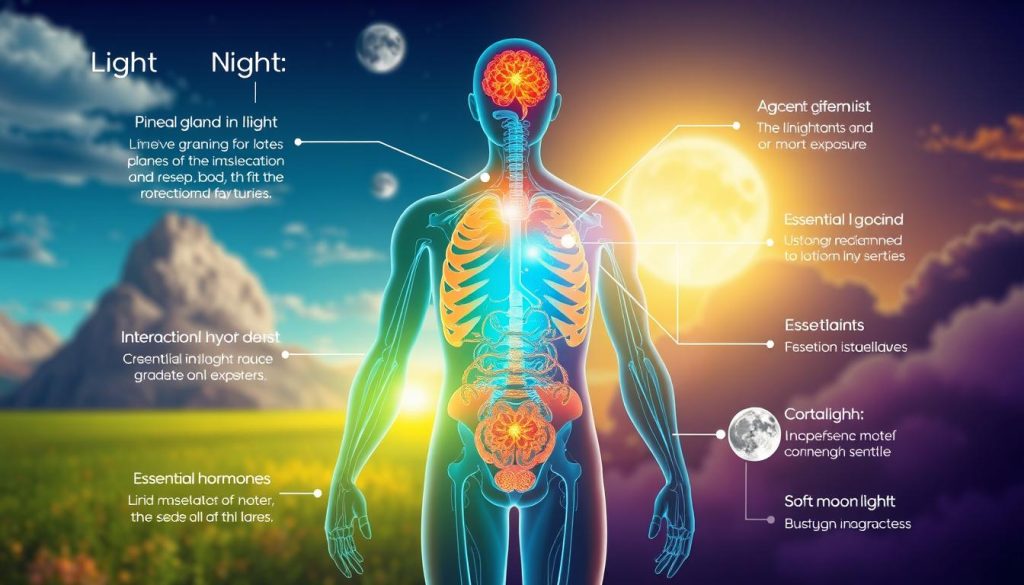Knowing my circadian rhythm is key to better time management and daily productivity. My biological clock affects my energy levels, impacting how well I do tasks. By matching my schedule with these natural cycles, I can reach my full potential and achieve more.
In this article, I’ll share ways to find my most productive hours. I’ll also talk about how to beat distractions and irregular sleep patterns. These strategies will help you create routines that boost your daily success.
Understanding My Circadian Rhythm
Circadian rhythms are key to my well-being and daily life. They control my body’s functions over a 24-hour cycle. Knowing about circadian rhythms helps me understand my body’s responses, like sleep and hormone release. It also improves my productivity and health.
Defining Circadian Rhythm
The circadian rhythm is about my biological clock. It tells me when to be awake or sleepy. Light and my daily routine affect it. My body adjusts to stay alert or relaxed at the right times.
How My Biological Clock Influences My Daily Life
My biological clock shapes my daily routine. In the morning, it releases energizing hormones. At night, it prepares me for sleep by reducing these hormones and increasing melatonin. This helps me stay focused and energetic during the day.

Disruptions, like late-night screens, can harm my health and work. It’s vital to respect my biological clock. This ensures better sleep and daily performance.
The Science Behind Circadian Rhythms
Exploring the science of circadian rhythms shows how our bodies work. The suprachiasmatic nucleus (SCN) in our brain is like a master clock. It controls hormone levels, including melatonin, which is key for sleep.
Biological Mechanisms at Play
Learning about our circadian rhythms is fascinating. The SCN gets signals from our eyes about light. This affects when we make melatonin.
In the day, light keeps us awake and alert. As night falls, our body starts making melatonin. This tells us it’s time to sleep.
Impact of Light and Darkness on My Body
Light is crucial for our daily lives. Bright light in the day keeps us energized. Without light, melatonin helps us sleep.
This balance shows how light and dark impact our health. Knowing this, we can adjust our routines. This improves our productivity and sleep.

How to Identify My Peak Productivity Hours
Figuring out when I’m most productive is key to better time management. Knowing when I’m sharp and focused helps me plan my tasks. This guide will show you how to track your energy and use tools to help.
Tracking My Energy Levels Throughout the Day
Tracking my energy is crucial to find my peak hours. I check my energy by feeling my mood and focus. I even give myself a score to see how I’m doing over time.
Small changes in my day, like when I eat or exercise, can really affect my energy.
Utilizing Journals and Apps for Monitoring
I use journals and apps to track my productivity. Journals help me reflect on my energy and feelings. Apps like Toggl and RescueTime track how I spend my time automatically.
![]()
Combining journals and apps gives me a detailed view of my energy. This helps me plan my work better. I can do more with less effort.
| Time of Day | Energy Level (1-10) | Task Type |
|---|---|---|
| 6 AM – 8 AM | 7 | Creative Tasks |
| 9 AM – 11 AM | 9 | Focused Work |
| 11 AM – 1 PM | 6 | Meetings |
| 2 PM – 4 PM | 8 | Analytical Tasks |
| 4 PM – 6 PM | 5 | Routine Tasks |
Circadian Rhythm and Time Management
Learning to match my schedule with my body’s natural rhythm boosts my productivity. This method lets me use my body’s energy peaks to my advantage. It makes my day more efficient and satisfying.
Aligning My Schedule with Natural Rhythms
I plan my day based on when I have the most and least energy. I tackle hard tasks like creative work when I’m most alert. Routine tasks, like checking emails, are done when I’m less energetic. This way, I avoid getting tired and stay focused.
Strategies for Enhancing Daily Productivity
Using smart time management boosts my performance. Here are some tips that help me stay productive:
- I do my most challenging tasks in the morning when I’m most alert.
- I break big projects into smaller parts and finish them when I’m most focused.
- I take short, regular breaks to keep my mind sharp, not long ones.
- I keep my workspace tidy to quickly switch between tasks and save time.
- I try different work schedules to find what works best for me.
Creating a Daily Routine Based on My Circadian Rhythm
Creating a daily routine that matches my circadian rhythm is key for better productivity and health. A good morning ritual sets a positive tone for the day. It gets my mind and body ready for focused work later. Here’s how I organize these important parts.
Setting Up My Morning Ritual
My morning ritual is a crucial part of my day. It includes activities that wake me up and get me ready:
- Stretching to awaken my body and improve circulation
- Practicing meditation to clear my mind and enhance focus
- Enjoying a healthy breakfast loaded with nutrients
This routine helps me start the day feeling clear and energized. It makes it easier to move into my work schedule.
Structuring Work Blocks for Greater Focus
To boost my productivity, I set up focused work blocks during my best energy times. I tackle my toughest tasks when I’m most energetic. I save less demanding tasks for when I’m not as sharp. Here’s how I organize my work blocks:
| Time Slot | Activity Type | Description |
|---|---|---|
| 8:00 AM – 10:00 AM | Focused Work Block | Engage in high-priority tasks that require maximum concentration. |
| 10:00 AM – 10:30 AM | Break | Short walk or light stretching to recharge. |
| 10:30 AM – 12:30 PM | Focused Work Block | Continue with significant projects, maintaining intensity. |
| 12:30 PM – 1:30 PM | Lunch | Healthy meal to fuel my productivity for the afternoon. |
| 1:30 PM – 3:30 PM | Low-Energy Tasks | Complete administrative tasks or respond to emails. |
By setting up focused work blocks and a meaningful morning ritual, I align my day with my natural rhythms. This helps me stay productive and balanced.
Overcoming Challenges in Time Management
Every day, we face different time management challenges. These can include distractions from our environment or irregular sleep patterns. To overcome these, we need strategies that fit our unique needs.
Managing Distractions in My Environment
To tackle environmental distractions, I’ve made some changes. Here are a few key steps:
- I’ve set up a quiet area for work to reduce interruptions.
- I use the Pomodoro Technique to focus in short, productive sessions.
- I turn off my phone and computer notifications to avoid distractions.
Dealing with Irregular Sleep Patterns
Irregular sleep can affect our productivity. To fight this, I’ve started a consistent bedtime routine. Simple steps include:
- I cut down on screen time an hour before bed to relax.
- I’ve made my bedroom sleep-friendly with dim lights and comfy bedding.
- I’ve adjusted my lifestyle, like cutting back on caffeine, to improve sleep.
By tackling these challenges, we can boost our productivity and overall well-being.
Implementing My Personalized Time Management Techniques
After learning about my body’s rhythms and how I work best, I created my own time management plan. I started by sorting tasks by how urgent and important they are. The Eisenhower Matrix helps me figure out what to do first.
This approach has become a key part of my day. It makes sure I focus on what’s most important. This way, I can tackle my tasks more efficiently.
I also keep changing my daily routine. Since my energy changes throughout the day, I adjust my schedule to match. This means moving less urgent tasks to when I’m more awake. It helps me do better at work and in my personal life.
By using these time management strategies, I aim for a balanced life. Paying attention to my body’s rhythms boosts my productivity. It also makes my daily tasks easier and more fun. Every small change helps me live a more organized and fulfilling life.

